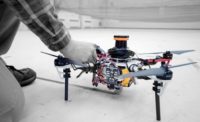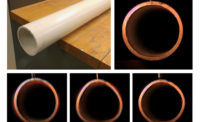A team of researchers recently shifted its operations to Edmonton, Alberta, from Hong Kong to continue development of a new alignment-control and surveying system for tunnel-boring operations. The city is helping with on-the job testing of the system, which is based on a successfully tested, smaller version for utility tunnels. Researchers aim to have a fully operational system for use in the construction of a large-diameter drainage tunnel this April.
“The tunneling industry is losing productivity and having problems with quality control” because it lacks real-time survey data, says Ming Lu, associate professor at the University of Alberta. He says the problem is exacerbated by a shortage of Canadian tunnel-boring-machine operators and tunneling engineers. The few available, experienced operators who are able to control a tunnel’s alignment with precision are in high demand and are bouncing between Edmonton's three ongoing drainage tunnel projects, he says.
“The problem is, if [the expert operators] don’t return in time, the entire tunnel could misalign, and it would take a fortune to save,” Lu says. The tunnel that will test Lu's system is one of three 8-ft to 12-ft-dia drainage tunnels that have a combined length of three kilometers and a price tag of $50 million.
The tunnels are meant to divert floodwater away from Edmonton. "The city gets flooded every five years or so, and the tunnels are meant to guard against that," says Tim Schneider, chief tunnel surveyor for Edmonton.
The new alignment technology uses a total station behind the TBM to read three prism sensors mounted on the back of the machine. The total station collects the three-axis rotation angels—yaw, pitch and roll—of the machine, says Lu. “Point to angle, computing algorithms are used to predict" and pinpoint the orientation of the entire machine without the use of gyroscopes, inclinometers or compasses, he adds.
Lu’s system is expected to give real-time survey data even when the TBM is navigating curves—something difficult for surveyors, says Schneider. Further, the setup will give a real-time survey of the machine's track and location to a precision of 0.10°, making retroactive surveys unnecessary.
Schneider says his Canadian-made TBM can be equipped with a sophisticated array of electronics and sensors to track the position of the machine. However, buying, maintaining and operating the system is detailed work, interrupts the job and usually requires the services of imported German engineers—all reasons why Edmonton doesn’t use it.
Lu and his team base their current development on micro-tunneling research successfully tested in Hong Kong on a 200-meter-long, 4-ft-dia utility tunnel. In a micro-tunnel, the TBM is remote controlled, and the tunnel diameter is thinner, barring worker entry. Also, the tunnels are much shorter, and the TBM only has slurry pumps and pipeline following it to allow for a clear field of view for the total station, says Lu. "The prism sensors are mounted in the center of the rear of the TBM."
The TBM on the 12-ft-dia Canadian drainage tunnel project is much bigger than the one in Hong Kong, and the guidance apparatus must be configured in a different way. The drainage tunnel will have its sensors much closer together. The sensors will be clustered in the upper right-hand corner of the back side of the TBM because the trailing gantry—which hosts the electrical generator, ventilation system and support lines—obscures from view most of the back end of the TBM. To compensate, Lu's teammate Xuesong Shen, a postdoctoral fellow at Alberta University, is rewriting the algorithms.
Edmonton expects to be digging five tunnels simultaneously during the next six months, says Schneider. Monitoring tunnel alignment will require sending in surveyors on a weekly basis—at a minimum.







Post a comment to this article
Report Abusive Comment